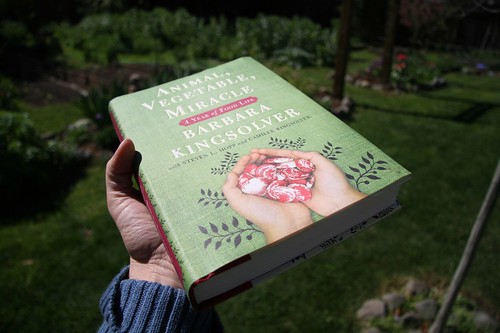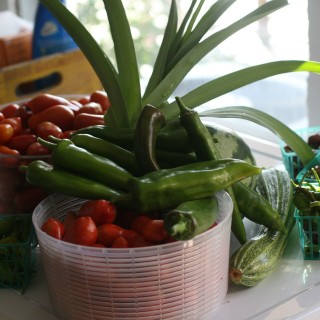Before I would have normally thought twice about buying that green bell pepper that my husband requested from the store yesterday, I mean, I know they are out of season and this poor little pepper was carted all the way up from Chile via precious fossil fuels just to add a little life to our potato hash. But after finishing Barbara Kingsolver’s “Animal, Vegetable, Miracle” last night, I feel really guilty.
We have always tried to eat with the seasons because we grow so much of our own fruit and veggies, but sometimes, like last night, you just have to have a bell pepper in the middle of March. Barbara and her industrious family of four commited to an entire year of eating locally and therefore in season. It was a very inspirational read, especially right at the beginning of gardening season. It’s one of those books that makes me want to immediately get out and start tomato, zucchini and basil seeds. Right now! Alas it’s a bit too early for us to do that. Maybe in the next couple of weeks.
Her casual and friendly writing style made me want to go visit her and walk through her garden with her. Meet her chickens and see her new turkey chicks. Her visit to the Farmer’s Diner in Vermont makes us daydream of opening such a restaurant here in Sonoma.
This quote by her husband Stephen is really eye opening:
Americans put almost as much fossil fuel into our refrigerators as our cars. We’re consuming about 400 gallons of oil a year per citizen – about 17% of our nation’s energy use – for agriculture, a close second to our vehicular use. Tractors, combines, harvesters, irrigation, sprayers, tillers, balers, and other equipment all use petroleum. Even bigger gas guzzlers on the farm are not the machines, but so-called inputs. Synthetic fertilizers, pesticides and herbicides use oil and natural gas as their starting materials, and in their manufacturing. More than a quarter of all farming energy goes into synthetic fertilizers.
But getting the crop from seed to harvest takes only one fifth of the total oil used for our food. The lion’s share is consumed during the trip from the farm to your plate. Each food item in a typical U.S. meal has traveled an average of 1500 miles. In addition to direct transport, other fuel-thirsty steps include processing (drying, milling, cutting, sorting, baking), packaging, warehousing and refrigeration. Energy calories consumed by production, packaging and shipping far outweigh the energy calories we receive from the food.
A quick way to improve food-related fuel economy would be to buy a quart of motor oil and drink it. More palatable options are available. If every U.S. citizen ate just one meal a week (any meal) composed of locally and organically raised meats and produce, we would reduce our country’s oil consumption by over 1.1 million barrels of oil every week. That’s not gallons, but barrels. Small changes in buying habits can make big differences. Becoming a less energy-dependent nation may just need to start with a good breakfast.
Steven L. Hopp
I don’t know if we’d be able to commit to a eating locally exclusively, but it sure makes me think. Think about finding meals that will accomodate whats in season, taking a second look at there the fruit is grown that I’m putting into my winter shopping bags, and of course it inspires me to garden!









I’ve been wanting to get this book- maybe before I leave for Chicago- I’m sure I’ll get a lot of reading done on the plane with 2 kids (we can be hopeful). I digress…. it takes me an hour in the produce section to shop. When you look at where the food comes from it’s just incredible. The other day I only left with 3 items – everything else was imported from all over. I do have one luxury item- bananas- Ryder loves them and so do we- we can’t seem to give that up. But everything else has to be grown either locally, or within a reasonable distance. It does make it difficult to shop but you feel good when you leave knowing your produce didn’t come from Argentina or Ecuador, etc. I know the best is to get to the farmers markets (which we have been going to the Friday one) but sometimes time doesn’t always allow it so I think the next best thing is to just be conscious while shopping. I can’t wait to get our garden going this summer! Nothing beats a tomato picked from your own garden.